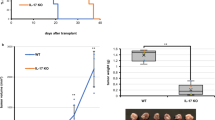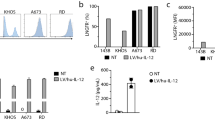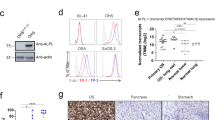Abstract
To establish an effective B7-based gene therapy against osteosarcoma, we transferred B7-1/Fas chimeric gene adenovirally into poorly immunogenic osteosarcoma cells. We found that adenovirus-mediated rat B7-1/Fas gene transfer induced (i) expression of rat B7-1/Fas chimeric molecules in osteosarcoma cells, (ii) activation of murine T cells, (iii) apoptosis of murine osteosarcoma cells in the presence of anti-rat B7-1 mAb in vitro, and (iv) therapeutic effects more prominently than B7-1 gene transfer on the development of pulmonary metastasis and survival of mice. These findings collectively support the therapeutic value of adenovirus-mediated B7-1/Fas gene transfer on poorly immunogenic osteosarcoma, which is resistant to a treatment protocol using transduction of B7-1 alone.
This is a preview of subscription content, access via your institution
Access options
Subscribe to this journal
Receive 12 print issues and online access
$259.00 per year
only $21.58 per issue
Buy this article
- Purchase on Springer Link
- Instant access to full article PDF
Prices may be subject to local taxes which are calculated during checkout










Similar content being viewed by others
References
Hayakawa M, Kawaguchi S, Ishii S, et al. B7-1-tranfected tumor vaccine counteracts chemotherapy-induced immunosuppression and prolongs the survival of rats bearing highly metastatic osteosarcoma cells. Int J Cancer. 1997;71:1091–1102.
Tsuji H, Kawaguchi S, Wada T, et al. Adenovirus-mediated in vivo B7-1 gene transfer induces anti-tumor immunity against pre-established primary tumor and pulmonary metastasis of rat osteosarcoma. Cancer Gene Ther. 2002;9:747–755.
Nagamori M, Kawaguchi S, Murakami M, et al. Intrinsic and extrinsic manipulation of B7/CTLA-4 interaction for induction of anti-tumor immunity against osteosarcoma cells. Anticancer Res. 2002;22:3223–3228.
Chen L, McGowan P, Ache S, et al. Tumor immunogenicity determines the effect of B7 costimulation on T cell-mediated tumor immunity. J Exp Med. 1994;179:523–532.
Chen L, McGowan P, Ache S, et al. B7-1/CD80-transduced tumor cells elicit better systemic immunity than wild-type tumor cells admixed with Corynebacterium parvum. Cancer Res. 1994;54:5420–5423.
Ueda T, Aoki Y, Yoshikawa H, et al. Establishment of highly pulmonary metastatic cell line of murine osteosarcoma. Jpn J Orthop Res. 1986;13:705–708.
Inobe M, Aoki N, Linsley PS, et al. The role of the B7-1a molecule, an alternatively spliced form of murine B7-1 (CD80), on T cell activation. J Immunol. 1996;157:582–588.
Maeda K, Sato T, Azuma M, et al. Characterization of rat CD80 and CD86 by molecular cloning and mAb. Int Immunol. 1997;9:993–1000.
Nabavi N, Freeman GJ, Gault A, et al. Signalling through the MHC class II cytoplasmic domain is required for antigen presentation and induces B7 expression. Nature. 1992;360:266–268.
Ogasawara K, Iwabuchi K, Kobayashi S, et al. An epitope on class II antigens that is maintained across species barriers and important in immunologic functions. Transplantation. 1987;43:427–432.
Sanchez-Madrid F, Simmon P, Thompson S, et al. Mapping of antigenic and functional epitopes on the a- and b-subunits of two related mouse glycoproteins involved in cell interactions, LFA-1 and MAC-1. J Exp Med. 1983;158:586–602.
Leo O, Foo M, Sachs H, et al. Identification of a monoclonal antibody specific for a murine T3 polypeptide. Proc Natl Acad Sci USA. 1987;84:1374–1378.
Inobe M, Linsley PS, Ledbetter JA, et al. Identification of an alternatively spliced form of the murine homologue of B7. Biochem Biophys Res Commun. 1994;200:443–449.
Miyake S, Makimura M, Kanegae Y, et al. Efficient generation of recombinant adenoviruses using adenovirus DNA–terminal protein complex and a cosmid bearing the full-length virus genome. Proc Natl Acad Sci USA. 1996;93:1320–1324.
Shinoura N, Ohashi M, Yoshida Y, et al. Construction, propagation, and titer estimation of recombinant adenoviruses carring proapoptotic genes. Hum Gene Ther. 1998;9:2683–2689.
Yang Y, Ertle J, Wilson JM . MHC class I-restricted cytotoxic T lymphocyte to viral antigens destroy hepatocytes in mice infected with E1-deleted recombinant adenoviruses. Immunity. 1994;1:433–442.
Hausen MB, Nielsen SE, Berg K . Re-examination and further development of a precise and rapid dye method for measuring cell growth/cell kill. J Immunol Methods. 1989;119:203–210.
Sellins KS, Cohen JJ . Gene induction by gamma-irradiation leads to DNA fragmentation in lymphocytes. J Immunol. 1987;139:3199–3206.
Koopman G, Reutelingsperger CP, Kutijten GA, et al. Annexin V for flow cytometric detection of phosphatidylserine expression on B cells undergoing apoptosis. Blood. 1994;84:1415–1420.
Chen L, Ashe S, Brady WA, et al. Co-stimulation of antitumor immunity by the B7 counterreceptor for the T-lymphocyte molecules CD28 and CTLA-4. Cell. 1992;71:1093–1102.
Townsend SE, Su FW, Atherton JM, et al. Specificity and longevity of antitumor immune responses induced by B7-transfected tumors. Cancer Res. 1994;54:6477–6483.
Harding FA, Allison JP . CD28–B7 interactions allow the induction of CD8+ cytotoxic T lymphocytes in the absence of exogenous help. J Exp Med. 1993;177:1791–1796.
Keene JA, Forman J . Helper activity is required for the in vivo generation of cytotoxic T lymphocytes. J Exp Med. 1982;155:768–782.
Bennett SRM, Carbone FR, Karamalis F, et al. Induction of a CD8+ cytotoxic T lymphocyte response by cross-priming requires cognate CD4+ T cell help. J Exp Med. 1997;186:65–70.
Takahashi T, Tanaka M, Ogasawara J, et al. Swapping between Fas and granulocyte colony-stimulating factor receptor. J Biol Chem. 1996;271:17555–17560.
Ishiwatari-Hayasaka H, Fujimoto T, Osawa T, et al. Requirements for signal delivery through CD44: analysis using CD44-Fas chimeric proteins. J Immunol. 1999;163:1258–1264.
Spencer DM, Belshaw PJ, Chen L, et al. Functional analysis of Fas signaling in vivo using systhetic inducers of dimerization. Curr. Biol. 1996;6:839–847.
Amara JF, Courage NL, Gilman M . Cell surface tagging and a suicide mechanism in a single chimeric human protein. Hum Gene Ther. 1999;10:2651–2655.
Emtage PC, Wan Y, Bramson JL, et al. A double recombinant adenovirus expressing the costimulatory molecule B7-1 (murine) and human IL-2 induces complete tumor regression in a murine adenocarcinoma model. J Immunol. 1998;160:2531–2538.
Putzer BM, Hitt M, Muller WJ, et al. Interleukin 12 and B7-1 costimulatory molecule expressed by an adenovirus vector act synergistically to facilitate tumor regression. Proc Natl Acad Sci USA. 1997;94:10889–10894.
Leach DR, Krummel MF, Allison JP . Enhancement of antitumor immunity by CTLA-4 blockade. Science. 1996;271:1734–1736.
Acknowledgements
We thank Drs Takafumi Ueda, Hirofumi Hamada, and Jeffrey A Bluestone for the kind donation of LM8 cells, 293-CrmA cells, and anti-CD3 mAb, respectively. We also thank M Kaya for technical assistance. This study was supported by the Grant-in-Aid provided by the Ministry of Education, Science, Sports, and Culture of Japan (Grant number: 11307026).
Author information
Authors and Affiliations
Corresponding author
Rights and permissions
About this article
Cite this article
Tsuji, H., Kawaguchi, S., Wada, T. et al. Concurrent induction of T-cell activation and apoptosis of osteosarcoma cells by adenovirus-mediated B7-1/Fas chimeric gene transfer. Cancer Gene Ther 10, 717–725 (2003). https://doi.org/10.1038/sj.cgt.7700624
Received:
Published:
Issue Date:
DOI: https://doi.org/10.1038/sj.cgt.7700624
Keywords
This article is cited by
-
Orthopedic Gene Therapy in 2008
Molecular Therapy (2009)
-
A quest for therapeutic antigens in bone and soft tissue sarcoma
Journal of Translational Medicine (2005)



